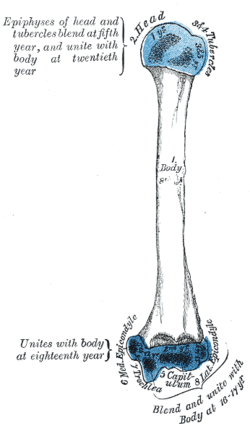Medial epicondyle of the humerus
| Medial epicondyle of the humerus | |
|---|---|
Left elbow-joint, showing anterior and ulnar collateral ligaments. (Medial epicondyle labeled at center top.) | |
 Plan of ossification of the humerus. (Medial epicondyle labeled at lower left.) | |
| Details | |
| Identifiers | |
| Latin | epicondylus medialis humeri |
| TA98 | A02.4.04.027 |
| TA2 | 1207 |
| FMA | 23441 |
| Anatomical terms of bone | |
The medial epicondyle of the humerus is an
The medial epicondyle gives attachment to the
The medial epicondyle protects the ulnar nerve, which runs in a groove on the back of this epicondyle. The ulnar nerve is vulnerable because it passes close to the surface along the back of the bone. Striking the medial epicondyle causes a tingling sensation in the ulnar nerve. This response is known as striking the "funny bone".[1] The name funny bone could be from a play on the words humorous and humerus, the bone on which the medial epicondyle is located,[2] although according to the Oxford English Dictionary, it may refer to "the peculiar sensation experienced when it is struck".[3] Medial epicondyle fracture of the humerus are common when falling onto an outstretched hand.
Fractures
Medial epicondyle fractures are common elbow injuries in children. There is considerable controversy about their treatment, with uncertainty about whether surgery to restore the natural position of the bone is better than healing in a cast.
Additional images
-
Right medial epicondyle colored in red.
-
Left humerus. Anterior view.
-
Front of the left forearm. Superficial muscles.
-
Posterior surface of the forearm. Deep muscles.
-
Elbow joint. Deep dissection. Posterior view.
-
Elbow joint. Deep dissection. Posterior view.
-
Elbow joint. Deep dissection. Posterior view.
References
![]() This article incorporates text in the public domain from page 212 of the 20th edition of Gray's Anatomy (1918)
This article incorporates text in the public domain from page 212 of the 20th edition of Gray's Anatomy (1918)
- ISBN 978-0071316385.
- ISBN 0-8160-5992-6.
- ^ "Welcome to the new OED Online : Oxford English Dictionary". Dictionary.oed.com. Retrieved 2012-03-20.
External links
- Anatomy figure: 07:02-02 at Human Anatomy Online, SUNY Downstate Medical Center
- Slim Golf Blog - Treating & Preventing Golfer's Elbow
- radiographsul at The Anatomy Lesson by Wesley Norman (Georgetown University) (xrayelbow)




